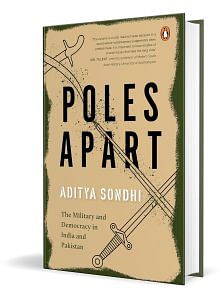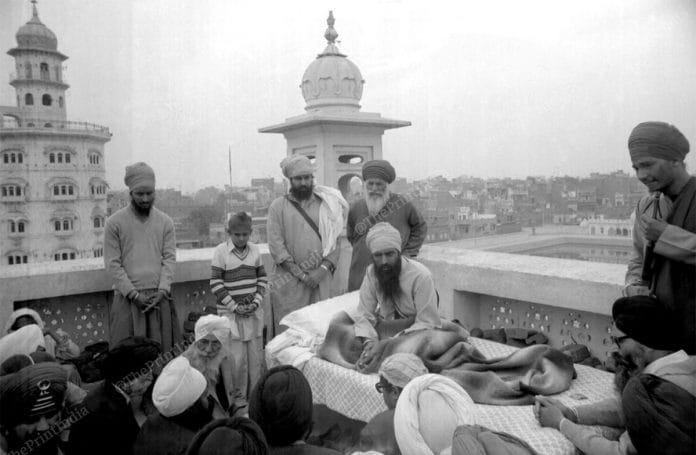The failure to contain the Bhindranwale menace resulted in knee-jerk reactions by the government whereby all Sikhs were viewed suspiciously and a large number of baseless arrests were made, which rightly infuriated the Sikh populace. Indira Gandhi once again attempted to negotiate, this time with the Akali Dal, through Captain Amarinder Singh (later chief minister of Punjab) and reached a tentative agreement on the issues of Chandigarh and the sharing of river waters. This agreement was dumped when the affected states—Haryana and Rajasthan—strongly opposed the pact.
Bhindranwale openly scorned the government and continued his unrestrained terror. In a daring episode, on 25 April 1983, the chief of the Amritsar Police, A.S. Atwal (a Sikh officer), was shot dead while leaving the precincts of the Golden Temple, as he was opposed to the idea of ‘Khalistan’. The government had not yet sanctioned police action against Bhindranwale, who moved his headquarters from the periphery into the heart of the temple—the sacred Akal Takht. In view of the growing terror and violence against innocent Hindus, Indira Gandhi dismissed Chief Minister Darbara Singh and inevitably imposed President’s rule, but the slaughter continued unabated.
For the first time, contingency military plans under the auspices of Rajiv Gandhi and his close supporters furtively began to be devised to smoke out Bhindranwale and his men from the Golden Temple, though the government was hesitant to invoke this drastic option. Unaware of these plans, Home Minister P.C. Sethi made a statement in Parliament that force would not be used in the Golden Temple.
Negotiations with Bhindranwale were thorny as he insisted on the unconditional implementation of the Anandpur Sahib Resolution demands. Simultaneously, Akali Dal leader Harchand Singh Longowal declared an impasse on the movement of grain out of Punjab, which was a key supplier of grain to the rest of the nation. The deadlock made intervention by force inevitable and on 5 June 1984, at 10.30 p.m., the 350 Infantry Brigade and attached troops of the Indian Army, commanded by Major General (later Lieutenant General) Kuldip Singh Brar, descended on Amritsar. Curfew was imposed, foreign media persons were evicted, communications terminated and borders frozen.
The professional nature of the Indian Army was evident as the siege of the hallowed Golden Temple was commanded by General Brar, himself a Sikh officer, who recalls how his Sikh soldiers volunteered to be the first to go into the temple premises to execute this most delicate operation against their ‘own people’. Interestingly, Bhindranwale’s key strategists in
the siege were retired army officers—Major General Shabeg Singh and Major General J.S. Bhullar.
General Brar was a Jat Sikh, whose ancestral village was a few miles from Bhindranwale’s. He was someone who knew Shabeg Singh intimately from the army. Brar confesses to having a high regard for Shabeg as a soldier, as he had served as Brar’s instructor at the IMA, Dehradun, and later had seen combat together in the 1971 operations. Brar was briefed by two lieutenant generals—K. Sundarji (who would later become COAS) and R.S. Dyal, a Sikh.
Also Read: ‘My helpless mother stood watching me being raped’—A Kaur recalls 1984 anti-Sikh violence
The official mandate to the forces was to use ‘minimum force’, to inflict ‘as little damage as possible’ and not to violate the holy sanctum sanctorum ‘Harmandir Sahib’, containing the holy book of the Sikhs, the Guru Granth Sahib. Earlier, the prime minister had expressly indicated that the army would not be sent into the Golden Temple at all.19 P.C. Alexander, Indira Gandhi’s principal secretary at the time, states unequivocally that even the military operations authorized by her in May 1984 were only to seize and fish out the terrorists, an order which was changed (very reluctantly) by the prime minister in June 1984—ostensibly at the instance of COAS General Vaidya, in consultation with Lieutenant General Sundarji—to ‘the usage of commando operations inside the Golden Temple’. General Sundarji, in turn, blamed the intelligence for poor information on the extent of infiltration.
From his refuge in the temple, Bhindranwale learnt of the developing military presence through his competent spies and insolently claimed, ‘If the authorities enter this temple, we will teach them such a lesson that the throne of Indira will crumble. We will slice them into small pieces . . . They will chew iron lentils . . . Let them come.’
The ‘look out sentries’ of the army found ‘armed militants’ in the precincts. On 5 June, the Indian Army ordered the civilians to leave the temple and, as a final warning, called upon the extremists to surrender. None of the extremists paid heed, forcing the army commandos to enter the fray. They were received with heavy downward gunfire from the temple terrace, using automatic weapons and causing large fatalities among the
soldiers.
The redoubtable response caused the army to use tanks and artillery to gain access to the temple complex. This naturally damaged the sacred construction and more significantly hurt the sentiments of the Sikhs, for whom this was an unpardonable incursion. The precious library of the Golden Temple, containing handwritten manuscripts by Sikh Gurus, was largely extinguished in combat firing and the Harmandir Sahib and Akal Takht were riddled with bullets. President Zail Singh—who was otherwise kept in the dark about the operation proclaimed:
[T]his [the Golden Temple] was the place built by the fifth
Guru, an apostle of peace, as a symbol of love and unity of
mankind. This was the temple of God . . . the shrine built on a
lower level than the surrounding land in a spirit of humility.
It has doors on all four sides proclaiming its accessibility
to people of all faiths and creeds. It had taken an act of
desecration to destroy Bhindranwale.
Late on the night of 6 June, the army finally entered the shrine and found Bhindranwale’s dead body along with several of his men. This put an end to the encounter, with several hundred commandos and civilians killed in the process. Lieutenant General J.S. Aurora, the Sikh general who commanded the army in the 1971 operations, pithily said, ‘The army was used to finish a problem created by the government. This is the kind of action that is going to ruin the army.’ (Emphasis supplied.)
However, despite the severely provocative nature of the assignment, the army acquitted itself as a dispassionate and efficient institution. Kirpal Dhillon, who was director general of police (DGP) Punjab, at the time, makes an important observation. He notes that in times such as Operation Blue Star, the army functions as per the manual of military aid to civil authority, as there is no express provision for martial law under the Indian Constitution. This would require orders to emanate from the local district magistrate. However, the army was accustomed to being beyond civilian scrutiny in matters of its operations—what the author puts down to a ‘colonial hangover’—and chose to operate dehors such protocol. For instance, detenus were not presented before the local magistrate within the twenty-four-hour period prescribed, and this often required the DGP to fly to Amritsar, along with the security adviser, to ‘fix the many legal infirmities’.
 This excerpt from ‘Poles Apart: The Military and Democracy in India and Pakistan’ has been published with permission from Penguin Random House India.
This excerpt from ‘Poles Apart: The Military and Democracy in India and Pakistan’ has been published with permission from Penguin Random House India.






